Strategic Management Case Study: Analyzing AirAsia's Strategies
VerifiedAdded on 2023/06/11
|23
|5754
|374
Case Study
AI Summary
This case study provides a detailed analysis of AirAsia's strategic management, examining both external and internal factors influencing its business operations. It includes a SWOT analysis identifying the airline's strengths, weaknesses, opportunities, and threats, and explores business-level and functional-level strategies focusing on human resources, financial resources, and marketing. The study discusses the impact of leadership, culture, and ethics on organizational strategy, highlighting the importance of workforce diversity and resource management. It also designs a practical business goal using the SMART framework and evaluates AirAsia's competitive advantages, vertical integration, diversification, and strategic alliances. Furthermore, the case study touches on motivational theories, performance measurement, and change management strategies within AirAsia. Desklib offers a platform for students to access this and many other solved assignments for academic support.
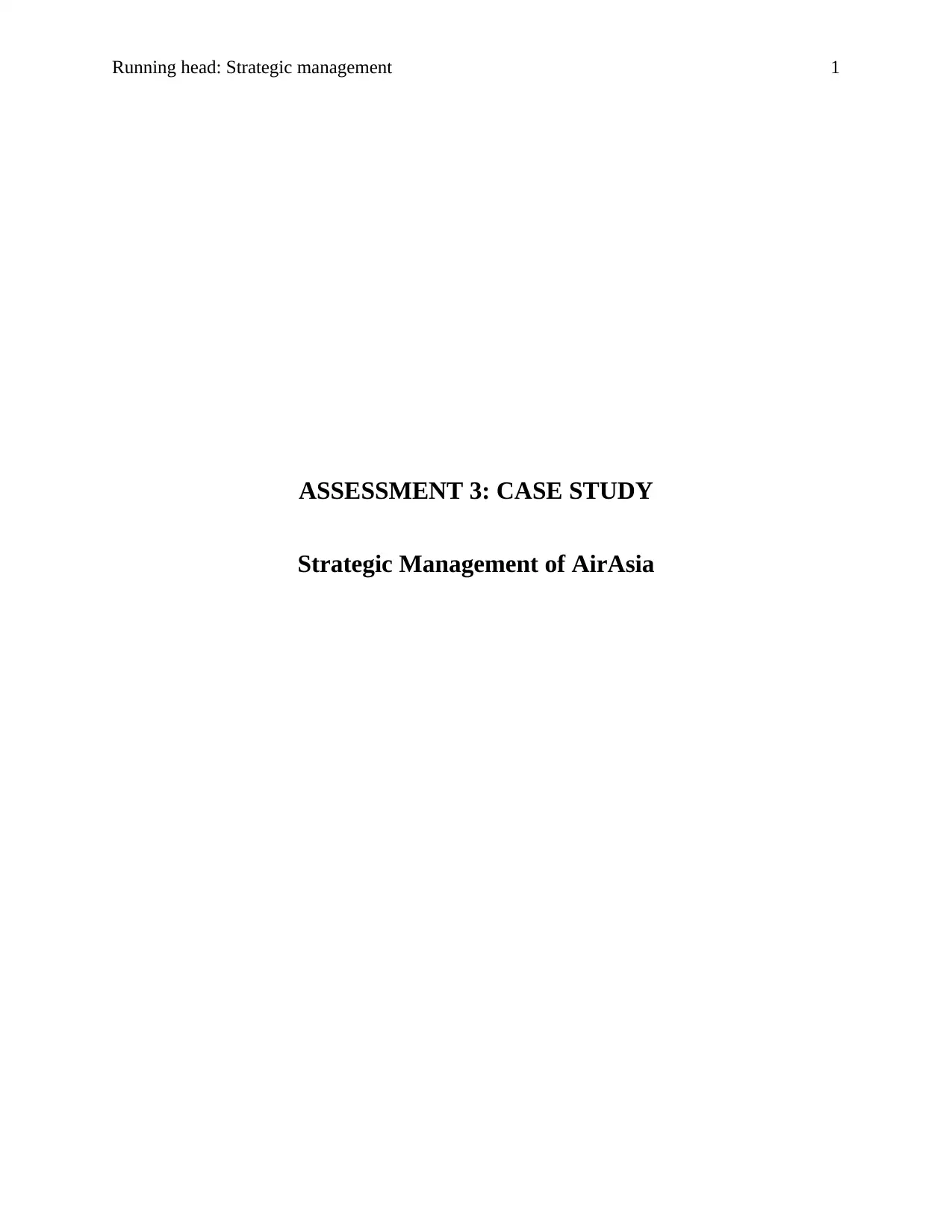
Running head: Strategic management 1
ASSESSMENT 3: CASE STUDY
Strategic Management of AirAsia
ASSESSMENT 3: CASE STUDY
Strategic Management of AirAsia
Paraphrase This Document
Need a fresh take? Get an instant paraphrase of this document with our AI Paraphraser
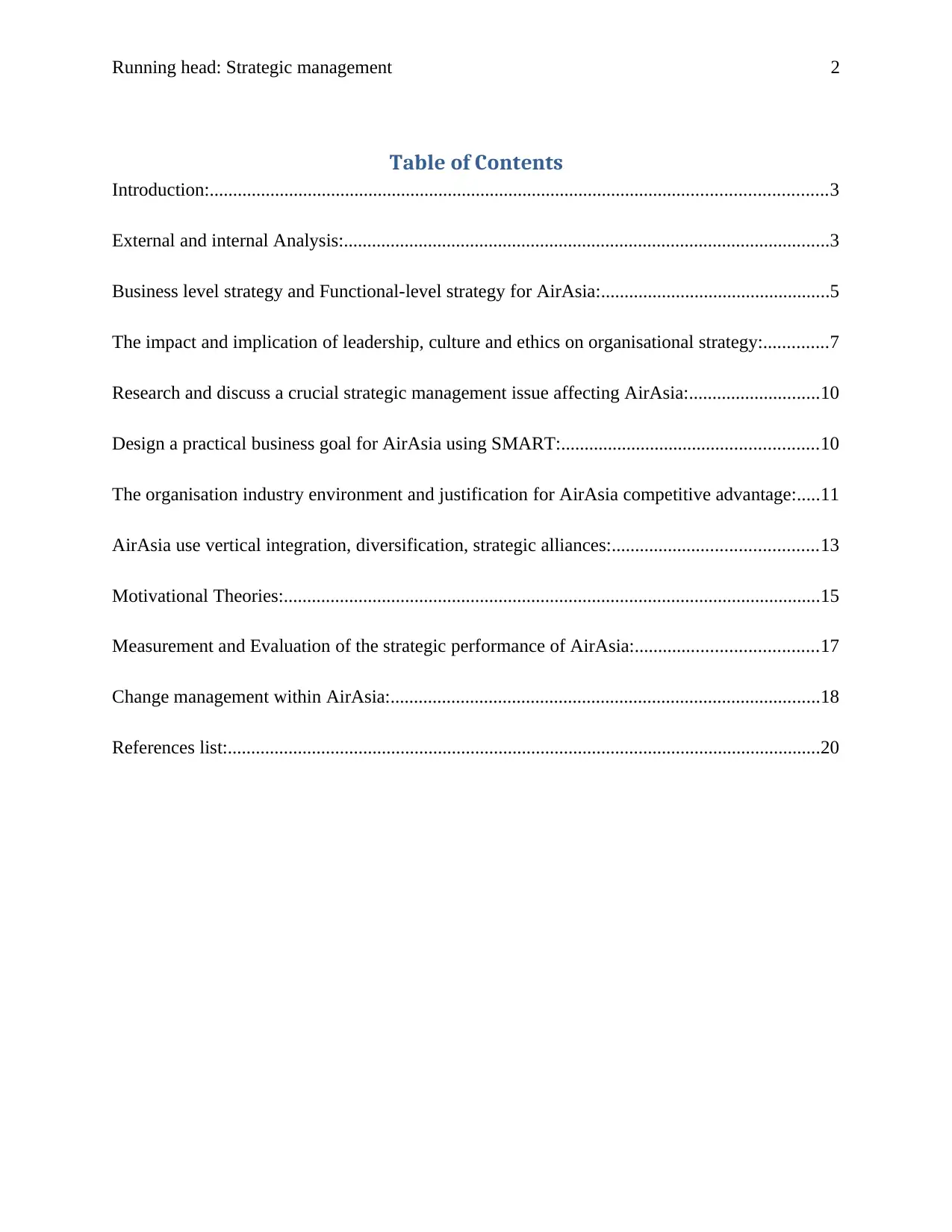
Running head: Strategic management 2
Table of Contents
Introduction:....................................................................................................................................3
External and internal Analysis:........................................................................................................3
Business level strategy and Functional-level strategy for AirAsia:.................................................5
The impact and implication of leadership, culture and ethics on organisational strategy:..............7
Research and discuss a crucial strategic management issue affecting AirAsia:............................10
Design a practical business goal for AirAsia using SMART:.......................................................10
The organisation industry environment and justification for AirAsia competitive advantage:.....11
AirAsia use vertical integration, diversification, strategic alliances:............................................13
Motivational Theories:...................................................................................................................15
Measurement and Evaluation of the strategic performance of AirAsia:.......................................17
Change management within AirAsia:............................................................................................18
References list:...............................................................................................................................20
Table of Contents
Introduction:....................................................................................................................................3
External and internal Analysis:........................................................................................................3
Business level strategy and Functional-level strategy for AirAsia:.................................................5
The impact and implication of leadership, culture and ethics on organisational strategy:..............7
Research and discuss a crucial strategic management issue affecting AirAsia:............................10
Design a practical business goal for AirAsia using SMART:.......................................................10
The organisation industry environment and justification for AirAsia competitive advantage:.....11
AirAsia use vertical integration, diversification, strategic alliances:............................................13
Motivational Theories:...................................................................................................................15
Measurement and Evaluation of the strategic performance of AirAsia:.......................................17
Change management within AirAsia:............................................................................................18
References list:...............................................................................................................................20
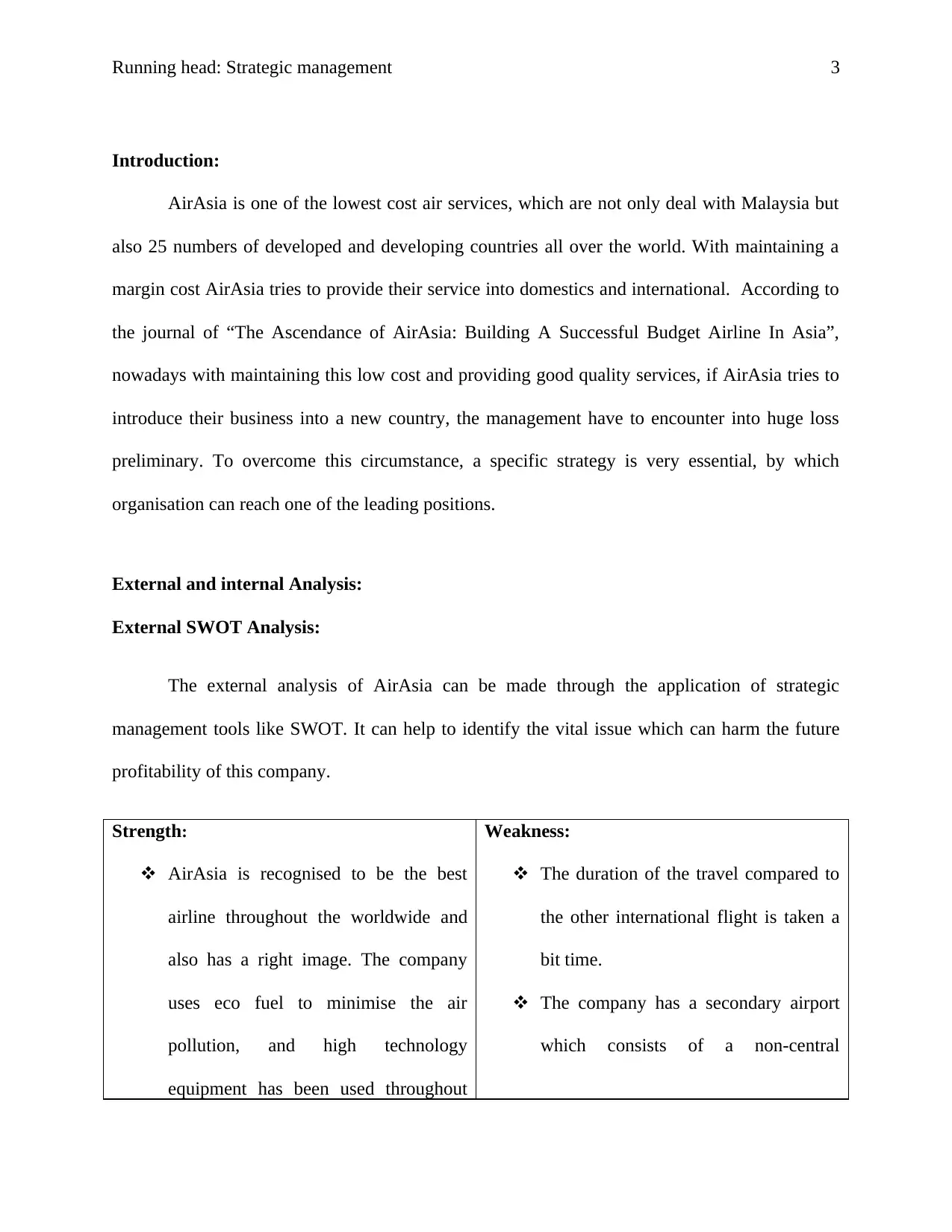
Running head: Strategic management 3
Introduction:
AirAsia is one of the lowest cost air services, which are not only deal with Malaysia but
also 25 numbers of developed and developing countries all over the world. With maintaining a
margin cost AirAsia tries to provide their service into domestics and international. According to
the journal of “The Ascendance of AirAsia: Building A Successful Budget Airline In Asia”,
nowadays with maintaining this low cost and providing good quality services, if AirAsia tries to
introduce their business into a new country, the management have to encounter into huge loss
preliminary. To overcome this circumstance, a specific strategy is very essential, by which
organisation can reach one of the leading positions.
External and internal Analysis:
External SWOT Analysis:
The external analysis of AirAsia can be made through the application of strategic
management tools like SWOT. It can help to identify the vital issue which can harm the future
profitability of this company.
Strength:
AirAsia is recognised to be the best
airline throughout the worldwide and
also has a right image. The company
uses eco fuel to minimise the air
pollution, and high technology
equipment has been used throughout
Weakness:
The duration of the travel compared to
the other international flight is taken a
bit time.
The company has a secondary airport
which consists of a non-central
Introduction:
AirAsia is one of the lowest cost air services, which are not only deal with Malaysia but
also 25 numbers of developed and developing countries all over the world. With maintaining a
margin cost AirAsia tries to provide their service into domestics and international. According to
the journal of “The Ascendance of AirAsia: Building A Successful Budget Airline In Asia”,
nowadays with maintaining this low cost and providing good quality services, if AirAsia tries to
introduce their business into a new country, the management have to encounter into huge loss
preliminary. To overcome this circumstance, a specific strategy is very essential, by which
organisation can reach one of the leading positions.
External and internal Analysis:
External SWOT Analysis:
The external analysis of AirAsia can be made through the application of strategic
management tools like SWOT. It can help to identify the vital issue which can harm the future
profitability of this company.
Strength:
AirAsia is recognised to be the best
airline throughout the worldwide and
also has a right image. The company
uses eco fuel to minimise the air
pollution, and high technology
equipment has been used throughout
Weakness:
The duration of the travel compared to
the other international flight is taken a
bit time.
The company has a secondary airport
which consists of a non-central
⊘ This is a preview!⊘
Do you want full access?
Subscribe today to unlock all pages.

Trusted by 1+ million students worldwide
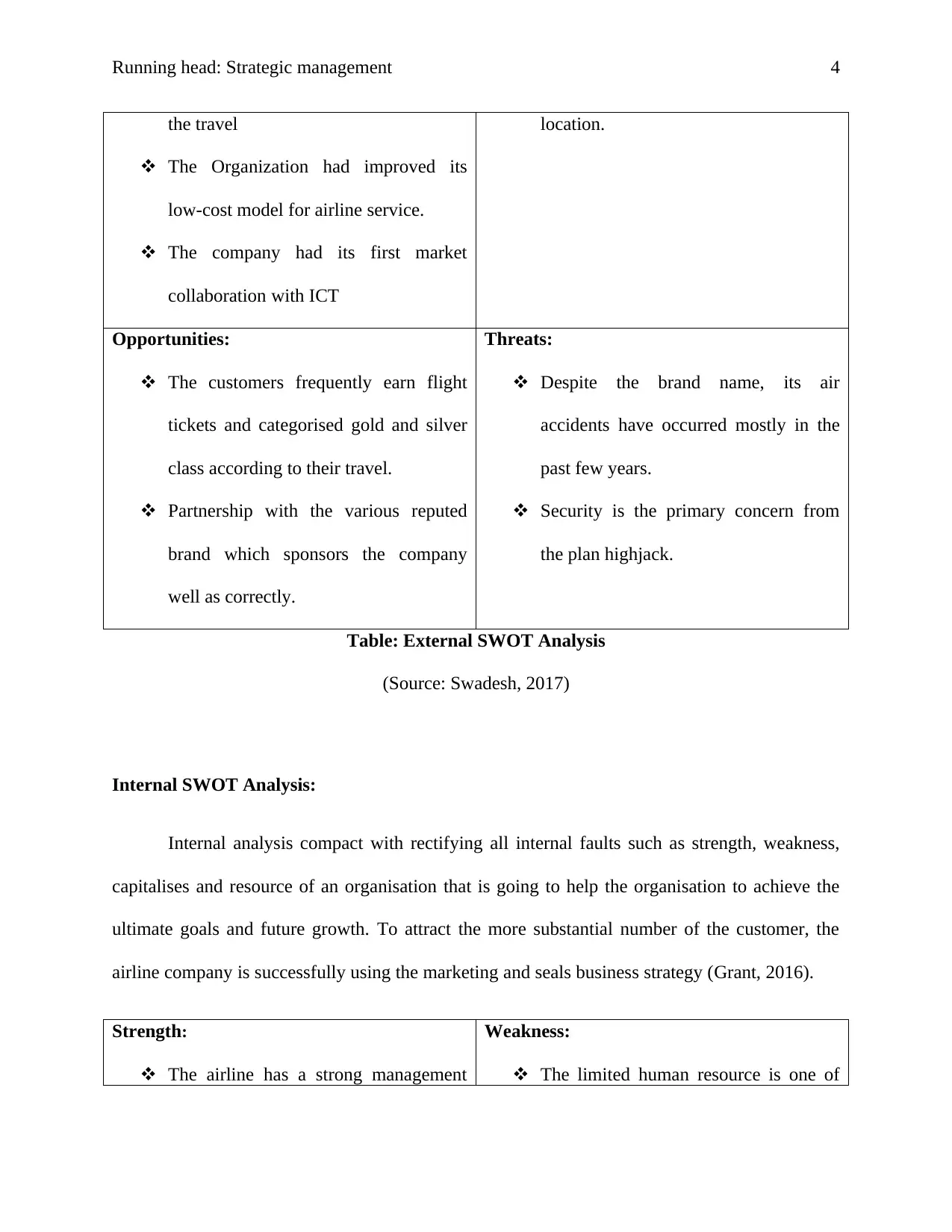
Running head: Strategic management 4
the travel
The Organization had improved its
low-cost model for airline service.
The company had its first market
collaboration with ICT
location.
Opportunities:
The customers frequently earn flight
tickets and categorised gold and silver
class according to their travel.
Partnership with the various reputed
brand which sponsors the company
well as correctly.
Threats:
Despite the brand name, its air
accidents have occurred mostly in the
past few years.
Security is the primary concern from
the plan highjack.
Table: External SWOT Analysis
(Source: Swadesh, 2017)
Internal SWOT Analysis:
Internal analysis compact with rectifying all internal faults such as strength, weakness,
capitalises and resource of an organisation that is going to help the organisation to achieve the
ultimate goals and future growth. To attract the more substantial number of the customer, the
airline company is successfully using the marketing and seals business strategy (Grant, 2016).
Strength:
The airline has a strong management
Weakness:
The limited human resource is one of
the travel
The Organization had improved its
low-cost model for airline service.
The company had its first market
collaboration with ICT
location.
Opportunities:
The customers frequently earn flight
tickets and categorised gold and silver
class according to their travel.
Partnership with the various reputed
brand which sponsors the company
well as correctly.
Threats:
Despite the brand name, its air
accidents have occurred mostly in the
past few years.
Security is the primary concern from
the plan highjack.
Table: External SWOT Analysis
(Source: Swadesh, 2017)
Internal SWOT Analysis:
Internal analysis compact with rectifying all internal faults such as strength, weakness,
capitalises and resource of an organisation that is going to help the organisation to achieve the
ultimate goals and future growth. To attract the more substantial number of the customer, the
airline company is successfully using the marketing and seals business strategy (Grant, 2016).
Strength:
The airline has a strong management
Weakness:
The limited human resource is one of
Paraphrase This Document
Need a fresh take? Get an instant paraphrase of this document with our AI Paraphraser
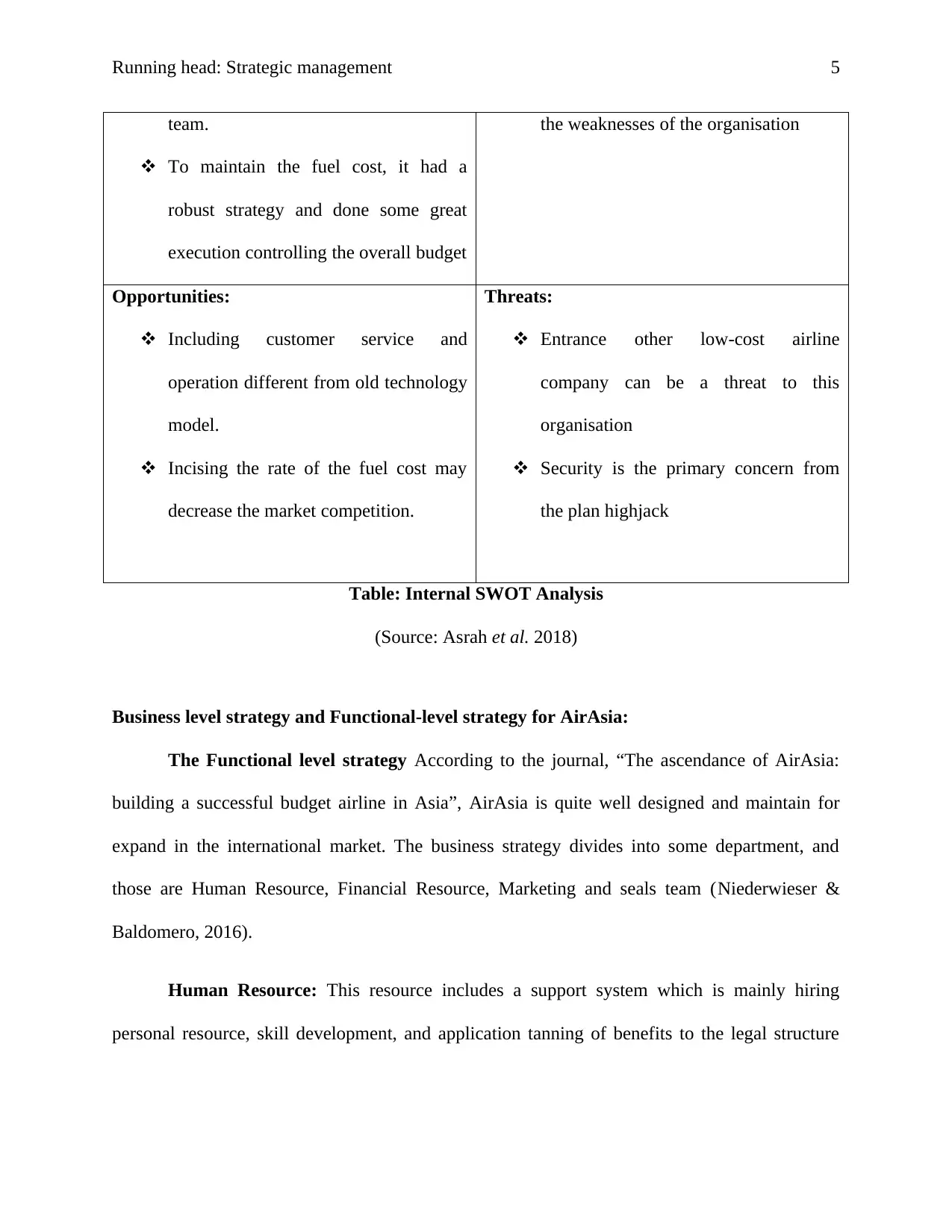
Running head: Strategic management 5
team.
To maintain the fuel cost, it had a
robust strategy and done some great
execution controlling the overall budget
the weaknesses of the organisation
Opportunities:
Including customer service and
operation different from old technology
model.
Incising the rate of the fuel cost may
decrease the market competition.
Threats:
Entrance other low-cost airline
company can be a threat to this
organisation
Security is the primary concern from
the plan highjack
Table: Internal SWOT Analysis
(Source: Asrah et al. 2018)
Business level strategy and Functional-level strategy for AirAsia:
The Functional level strategy According to the journal, “The ascendance of AirAsia:
building a successful budget airline in Asia”, AirAsia is quite well designed and maintain for
expand in the international market. The business strategy divides into some department, and
those are Human Resource, Financial Resource, Marketing and seals team (Niederwieser &
Baldomero, 2016).
Human Resource: This resource includes a support system which is mainly hiring
personal resource, skill development, and application tanning of benefits to the legal structure
team.
To maintain the fuel cost, it had a
robust strategy and done some great
execution controlling the overall budget
the weaknesses of the organisation
Opportunities:
Including customer service and
operation different from old technology
model.
Incising the rate of the fuel cost may
decrease the market competition.
Threats:
Entrance other low-cost airline
company can be a threat to this
organisation
Security is the primary concern from
the plan highjack
Table: Internal SWOT Analysis
(Source: Asrah et al. 2018)
Business level strategy and Functional-level strategy for AirAsia:
The Functional level strategy According to the journal, “The ascendance of AirAsia:
building a successful budget airline in Asia”, AirAsia is quite well designed and maintain for
expand in the international market. The business strategy divides into some department, and
those are Human Resource, Financial Resource, Marketing and seals team (Niederwieser &
Baldomero, 2016).
Human Resource: This resource includes a support system which is mainly hiring
personal resource, skill development, and application tanning of benefits to the legal structure
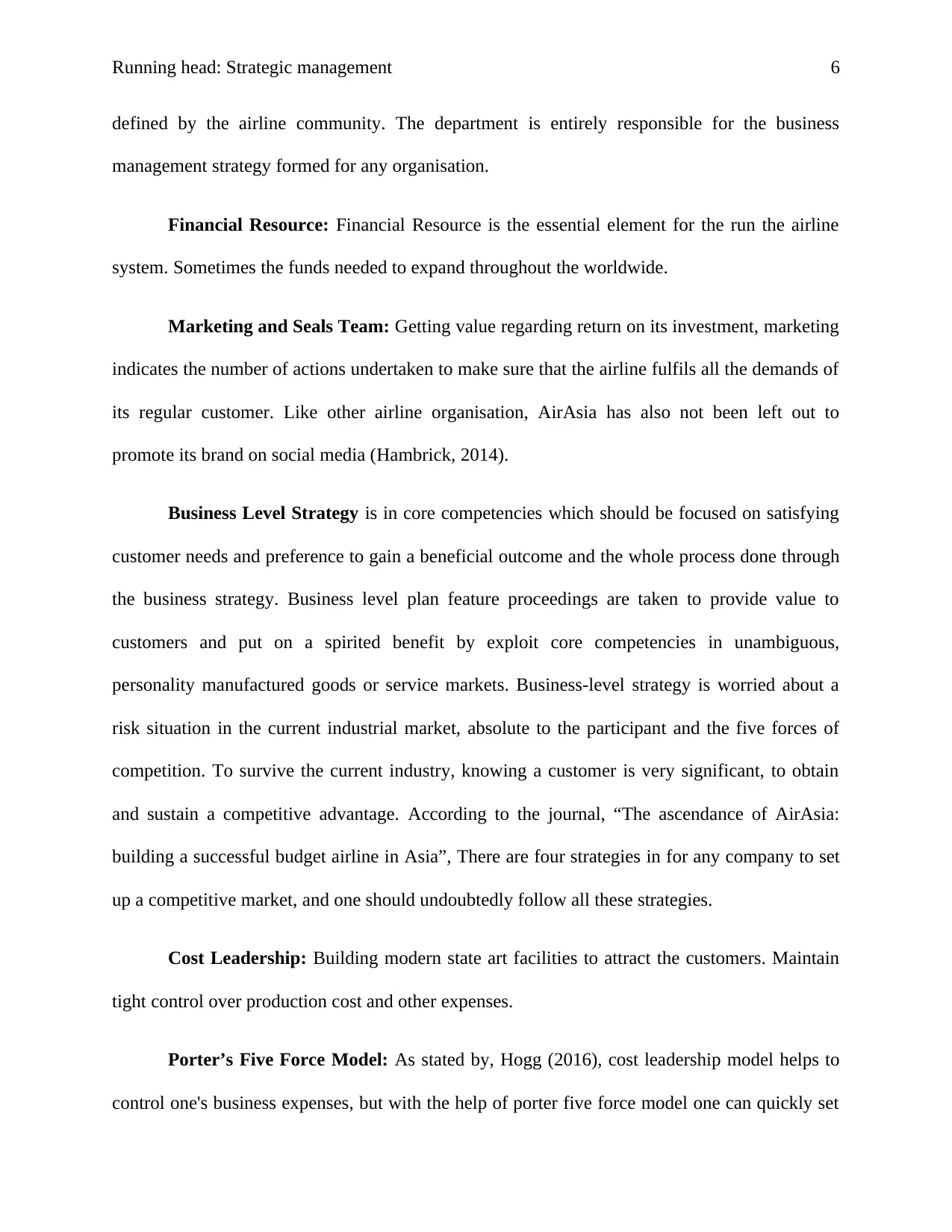
Running head: Strategic management 6
defined by the airline community. The department is entirely responsible for the business
management strategy formed for any organisation.
Financial Resource: Financial Resource is the essential element for the run the airline
system. Sometimes the funds needed to expand throughout the worldwide.
Marketing and Seals Team: Getting value regarding return on its investment, marketing
indicates the number of actions undertaken to make sure that the airline fulfils all the demands of
its regular customer. Like other airline organisation, AirAsia has also not been left out to
promote its brand on social media (Hambrick, 2014).
Business Level Strategy is in core competencies which should be focused on satisfying
customer needs and preference to gain a beneficial outcome and the whole process done through
the business strategy. Business level plan feature proceedings are taken to provide value to
customers and put on a spirited benefit by exploit core competencies in unambiguous,
personality manufactured goods or service markets. Business-level strategy is worried about a
risk situation in the current industrial market, absolute to the participant and the five forces of
competition. To survive the current industry, knowing a customer is very significant, to obtain
and sustain a competitive advantage. According to the journal, “The ascendance of AirAsia:
building a successful budget airline in Asia”, There are four strategies in for any company to set
up a competitive market, and one should undoubtedly follow all these strategies.
Cost Leadership: Building modern state art facilities to attract the customers. Maintain
tight control over production cost and other expenses.
Porter’s Five Force Model: As stated by, Hogg (2016), cost leadership model helps to
control one's business expenses, but with the help of porter five force model one can quickly set
defined by the airline community. The department is entirely responsible for the business
management strategy formed for any organisation.
Financial Resource: Financial Resource is the essential element for the run the airline
system. Sometimes the funds needed to expand throughout the worldwide.
Marketing and Seals Team: Getting value regarding return on its investment, marketing
indicates the number of actions undertaken to make sure that the airline fulfils all the demands of
its regular customer. Like other airline organisation, AirAsia has also not been left out to
promote its brand on social media (Hambrick, 2014).
Business Level Strategy is in core competencies which should be focused on satisfying
customer needs and preference to gain a beneficial outcome and the whole process done through
the business strategy. Business level plan feature proceedings are taken to provide value to
customers and put on a spirited benefit by exploit core competencies in unambiguous,
personality manufactured goods or service markets. Business-level strategy is worried about a
risk situation in the current industrial market, absolute to the participant and the five forces of
competition. To survive the current industry, knowing a customer is very significant, to obtain
and sustain a competitive advantage. According to the journal, “The ascendance of AirAsia:
building a successful budget airline in Asia”, There are four strategies in for any company to set
up a competitive market, and one should undoubtedly follow all these strategies.
Cost Leadership: Building modern state art facilities to attract the customers. Maintain
tight control over production cost and other expenses.
Porter’s Five Force Model: As stated by, Hogg (2016), cost leadership model helps to
control one's business expenses, but with the help of porter five force model one can quickly set
⊘ This is a preview!⊘
Do you want full access?
Subscribe today to unlock all pages.

Trusted by 1+ million students worldwide
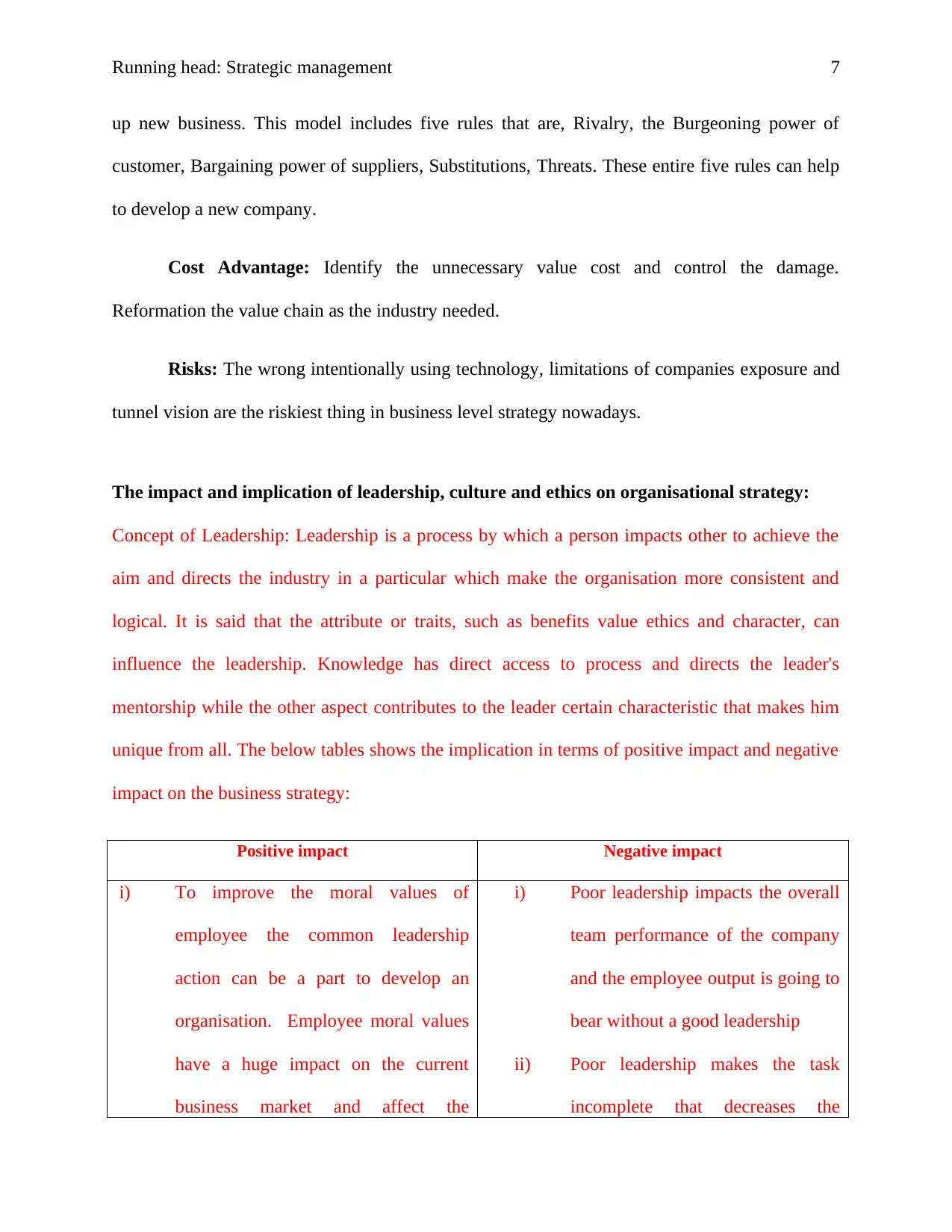
Running head: Strategic management 7
up new business. This model includes five rules that are, Rivalry, the Burgeoning power of
customer, Bargaining power of suppliers, Substitutions, Threats. These entire five rules can help
to develop a new company.
Cost Advantage: Identify the unnecessary value cost and control the damage.
Reformation the value chain as the industry needed.
Risks: The wrong intentionally using technology, limitations of companies exposure and
tunnel vision are the riskiest thing in business level strategy nowadays.
The impact and implication of leadership, culture and ethics on organisational strategy:
Concept of Leadership: Leadership is a process by which a person impacts other to achieve the
aim and directs the industry in a particular which make the organisation more consistent and
logical. It is said that the attribute or traits, such as benefits value ethics and character, can
influence the leadership. Knowledge has direct access to process and directs the leader's
mentorship while the other aspect contributes to the leader certain characteristic that makes him
unique from all. The below tables shows the implication in terms of positive impact and negative
impact on the business strategy:
Positive impact Negative impact
i) To improve the moral values of
employee the common leadership
action can be a part to develop an
organisation. Employee moral values
have a huge impact on the current
business market and affect the
i) Poor leadership impacts the overall
team performance of the company
and the employee output is going to
bear without a good leadership
ii) Poor leadership makes the task
incomplete that decreases the
up new business. This model includes five rules that are, Rivalry, the Burgeoning power of
customer, Bargaining power of suppliers, Substitutions, Threats. These entire five rules can help
to develop a new company.
Cost Advantage: Identify the unnecessary value cost and control the damage.
Reformation the value chain as the industry needed.
Risks: The wrong intentionally using technology, limitations of companies exposure and
tunnel vision are the riskiest thing in business level strategy nowadays.
The impact and implication of leadership, culture and ethics on organisational strategy:
Concept of Leadership: Leadership is a process by which a person impacts other to achieve the
aim and directs the industry in a particular which make the organisation more consistent and
logical. It is said that the attribute or traits, such as benefits value ethics and character, can
influence the leadership. Knowledge has direct access to process and directs the leader's
mentorship while the other aspect contributes to the leader certain characteristic that makes him
unique from all. The below tables shows the implication in terms of positive impact and negative
impact on the business strategy:
Positive impact Negative impact
i) To improve the moral values of
employee the common leadership
action can be a part to develop an
organisation. Employee moral values
have a huge impact on the current
business market and affect the
i) Poor leadership impacts the overall
team performance of the company
and the employee output is going to
bear without a good leadership
ii) Poor leadership makes the task
incomplete that decreases the
Paraphrase This Document
Need a fresh take? Get an instant paraphrase of this document with our AI Paraphraser
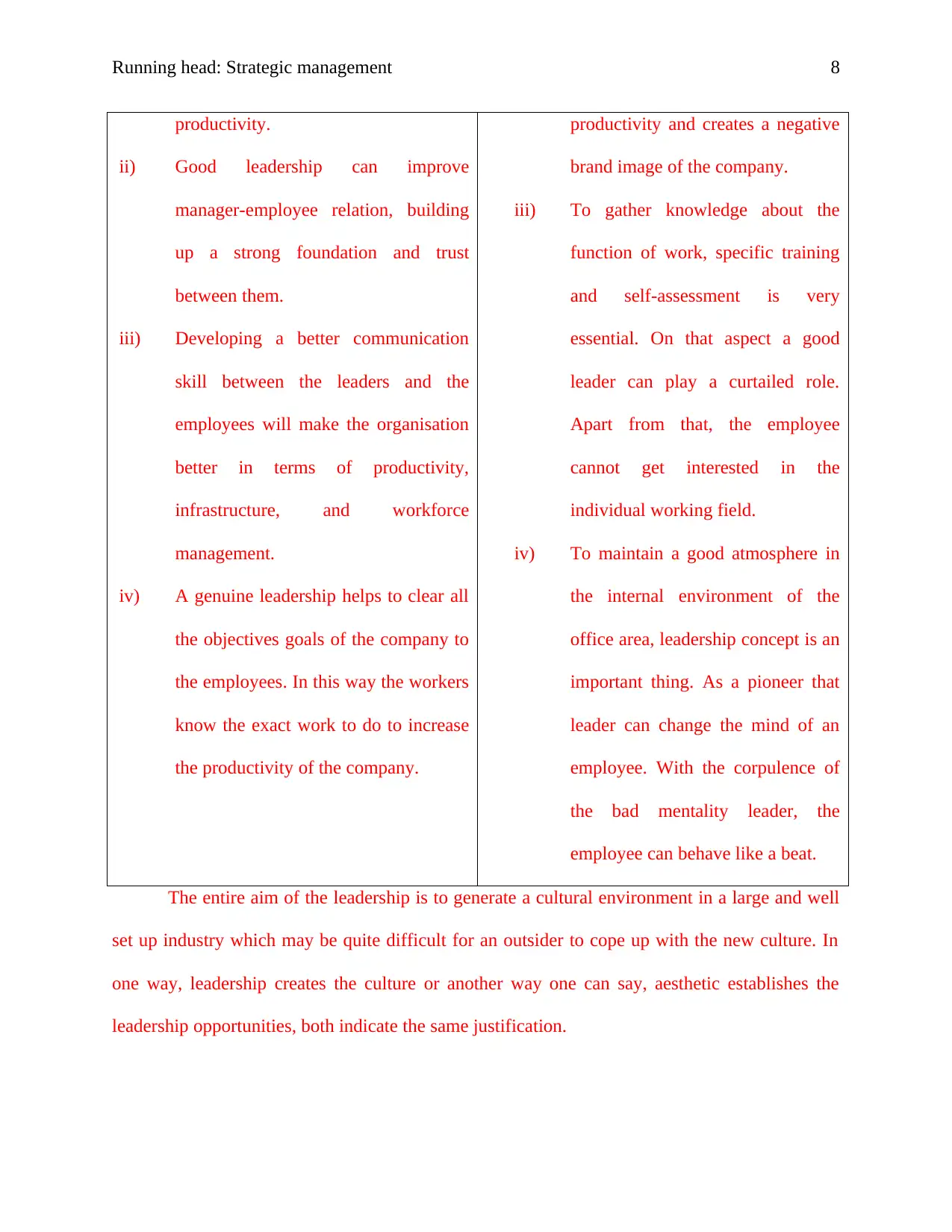
Running head: Strategic management 8
productivity.
ii) Good leadership can improve
manager-employee relation, building
up a strong foundation and trust
between them.
iii) Developing a better communication
skill between the leaders and the
employees will make the organisation
better in terms of productivity,
infrastructure, and workforce
management.
iv) A genuine leadership helps to clear all
the objectives goals of the company to
the employees. In this way the workers
know the exact work to do to increase
the productivity of the company.
productivity and creates a negative
brand image of the company.
iii) To gather knowledge about the
function of work, specific training
and self-assessment is very
essential. On that aspect a good
leader can play a curtailed role.
Apart from that, the employee
cannot get interested in the
individual working field.
iv) To maintain a good atmosphere in
the internal environment of the
office area, leadership concept is an
important thing. As a pioneer that
leader can change the mind of an
employee. With the corpulence of
the bad mentality leader, the
employee can behave like a beat.
The entire aim of the leadership is to generate a cultural environment in a large and well
set up industry which may be quite difficult for an outsider to cope up with the new culture. In
one way, leadership creates the culture or another way one can say, aesthetic establishes the
leadership opportunities, both indicate the same justification.
productivity.
ii) Good leadership can improve
manager-employee relation, building
up a strong foundation and trust
between them.
iii) Developing a better communication
skill between the leaders and the
employees will make the organisation
better in terms of productivity,
infrastructure, and workforce
management.
iv) A genuine leadership helps to clear all
the objectives goals of the company to
the employees. In this way the workers
know the exact work to do to increase
the productivity of the company.
productivity and creates a negative
brand image of the company.
iii) To gather knowledge about the
function of work, specific training
and self-assessment is very
essential. On that aspect a good
leader can play a curtailed role.
Apart from that, the employee
cannot get interested in the
individual working field.
iv) To maintain a good atmosphere in
the internal environment of the
office area, leadership concept is an
important thing. As a pioneer that
leader can change the mind of an
employee. With the corpulence of
the bad mentality leader, the
employee can behave like a beat.
The entire aim of the leadership is to generate a cultural environment in a large and well
set up industry which may be quite difficult for an outsider to cope up with the new culture. In
one way, leadership creates the culture or another way one can say, aesthetic establishes the
leadership opportunities, both indicate the same justification.
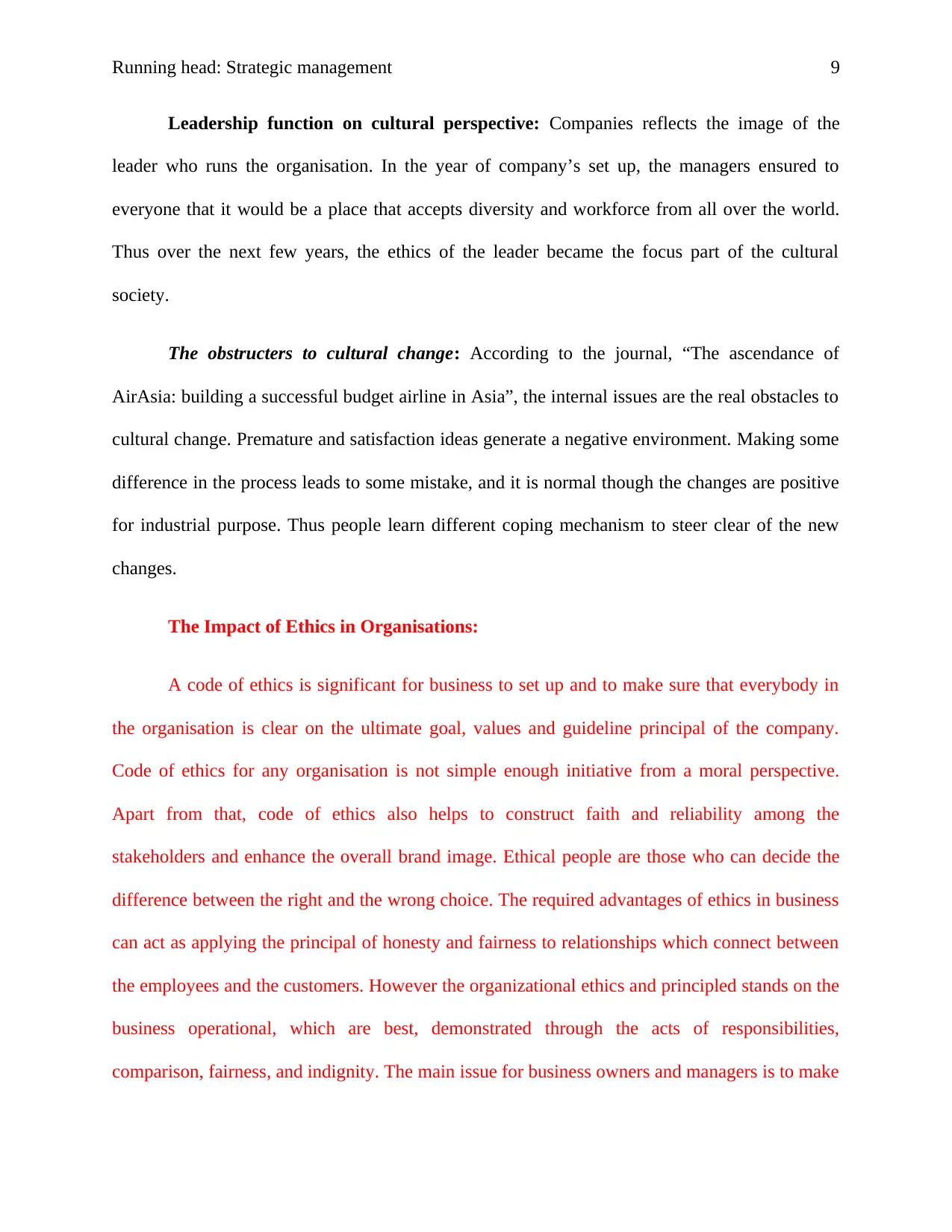
Running head: Strategic management 9
Leadership function on cultural perspective: Companies reflects the image of the
leader who runs the organisation. In the year of company’s set up, the managers ensured to
everyone that it would be a place that accepts diversity and workforce from all over the world.
Thus over the next few years, the ethics of the leader became the focus part of the cultural
society.
The obstructers to cultural change: According to the journal, “The ascendance of
AirAsia: building a successful budget airline in Asia”, the internal issues are the real obstacles to
cultural change. Premature and satisfaction ideas generate a negative environment. Making some
difference in the process leads to some mistake, and it is normal though the changes are positive
for industrial purpose. Thus people learn different coping mechanism to steer clear of the new
changes.
The Impact of Ethics in Organisations:
A code of ethics is significant for business to set up and to make sure that everybody in
the organisation is clear on the ultimate goal, values and guideline principal of the company.
Code of ethics for any organisation is not simple enough initiative from a moral perspective.
Apart from that, code of ethics also helps to construct faith and reliability among the
stakeholders and enhance the overall brand image. Ethical people are those who can decide the
difference between the right and the wrong choice. The required advantages of ethics in business
can act as applying the principal of honesty and fairness to relationships which connect between
the employees and the customers. However the organizational ethics and principled stands on the
business operational, which are best, demonstrated through the acts of responsibilities,
comparison, fairness, and indignity. The main issue for business owners and managers is to make
Leadership function on cultural perspective: Companies reflects the image of the
leader who runs the organisation. In the year of company’s set up, the managers ensured to
everyone that it would be a place that accepts diversity and workforce from all over the world.
Thus over the next few years, the ethics of the leader became the focus part of the cultural
society.
The obstructers to cultural change: According to the journal, “The ascendance of
AirAsia: building a successful budget airline in Asia”, the internal issues are the real obstacles to
cultural change. Premature and satisfaction ideas generate a negative environment. Making some
difference in the process leads to some mistake, and it is normal though the changes are positive
for industrial purpose. Thus people learn different coping mechanism to steer clear of the new
changes.
The Impact of Ethics in Organisations:
A code of ethics is significant for business to set up and to make sure that everybody in
the organisation is clear on the ultimate goal, values and guideline principal of the company.
Code of ethics for any organisation is not simple enough initiative from a moral perspective.
Apart from that, code of ethics also helps to construct faith and reliability among the
stakeholders and enhance the overall brand image. Ethical people are those who can decide the
difference between the right and the wrong choice. The required advantages of ethics in business
can act as applying the principal of honesty and fairness to relationships which connect between
the employees and the customers. However the organizational ethics and principled stands on the
business operational, which are best, demonstrated through the acts of responsibilities,
comparison, fairness, and indignity. The main issue for business owners and managers is to make
⊘ This is a preview!⊘
Do you want full access?
Subscribe today to unlock all pages.

Trusted by 1+ million students worldwide
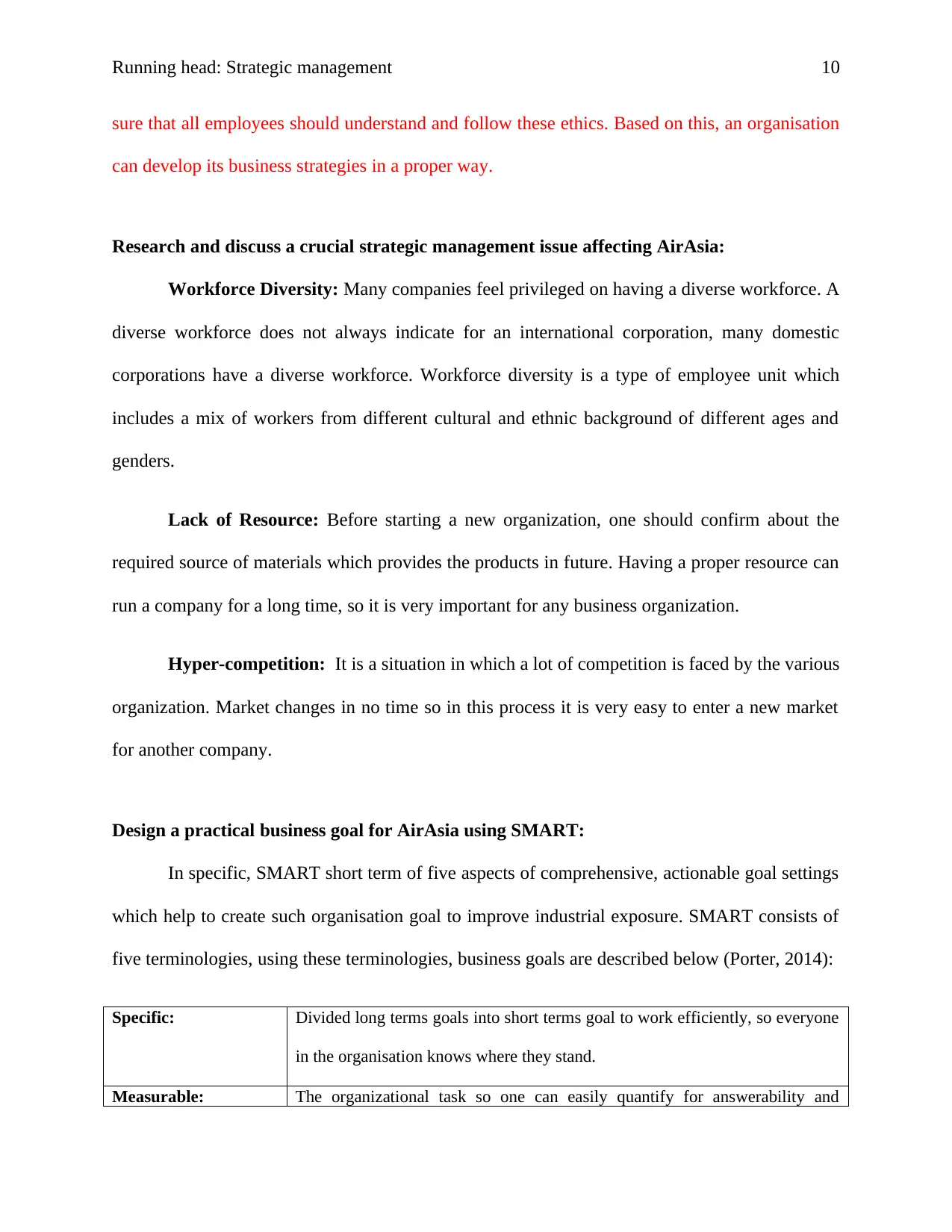
Running head: Strategic management 10
sure that all employees should understand and follow these ethics. Based on this, an organisation
can develop its business strategies in a proper way.
Research and discuss a crucial strategic management issue affecting AirAsia:
Workforce Diversity: Many companies feel privileged on having a diverse workforce. A
diverse workforce does not always indicate for an international corporation, many domestic
corporations have a diverse workforce. Workforce diversity is a type of employee unit which
includes a mix of workers from different cultural and ethnic background of different ages and
genders.
Lack of Resource: Before starting a new organization, one should confirm about the
required source of materials which provides the products in future. Having a proper resource can
run a company for a long time, so it is very important for any business organization.
Hyper-competition: It is a situation in which a lot of competition is faced by the various
organization. Market changes in no time so in this process it is very easy to enter a new market
for another company.
Design a practical business goal for AirAsia using SMART:
In specific, SMART short term of five aspects of comprehensive, actionable goal settings
which help to create such organisation goal to improve industrial exposure. SMART consists of
five terminologies, using these terminologies, business goals are described below (Porter, 2014):
Specific: Divided long terms goals into short terms goal to work efficiently, so everyone
in the organisation knows where they stand.
Measurable: The organizational task so one can easily quantify for answerability and
sure that all employees should understand and follow these ethics. Based on this, an organisation
can develop its business strategies in a proper way.
Research and discuss a crucial strategic management issue affecting AirAsia:
Workforce Diversity: Many companies feel privileged on having a diverse workforce. A
diverse workforce does not always indicate for an international corporation, many domestic
corporations have a diverse workforce. Workforce diversity is a type of employee unit which
includes a mix of workers from different cultural and ethnic background of different ages and
genders.
Lack of Resource: Before starting a new organization, one should confirm about the
required source of materials which provides the products in future. Having a proper resource can
run a company for a long time, so it is very important for any business organization.
Hyper-competition: It is a situation in which a lot of competition is faced by the various
organization. Market changes in no time so in this process it is very easy to enter a new market
for another company.
Design a practical business goal for AirAsia using SMART:
In specific, SMART short term of five aspects of comprehensive, actionable goal settings
which help to create such organisation goal to improve industrial exposure. SMART consists of
five terminologies, using these terminologies, business goals are described below (Porter, 2014):
Specific: Divided long terms goals into short terms goal to work efficiently, so everyone
in the organisation knows where they stand.
Measurable: The organizational task so one can easily quantify for answerability and
Paraphrase This Document
Need a fresh take? Get an instant paraphrase of this document with our AI Paraphraser
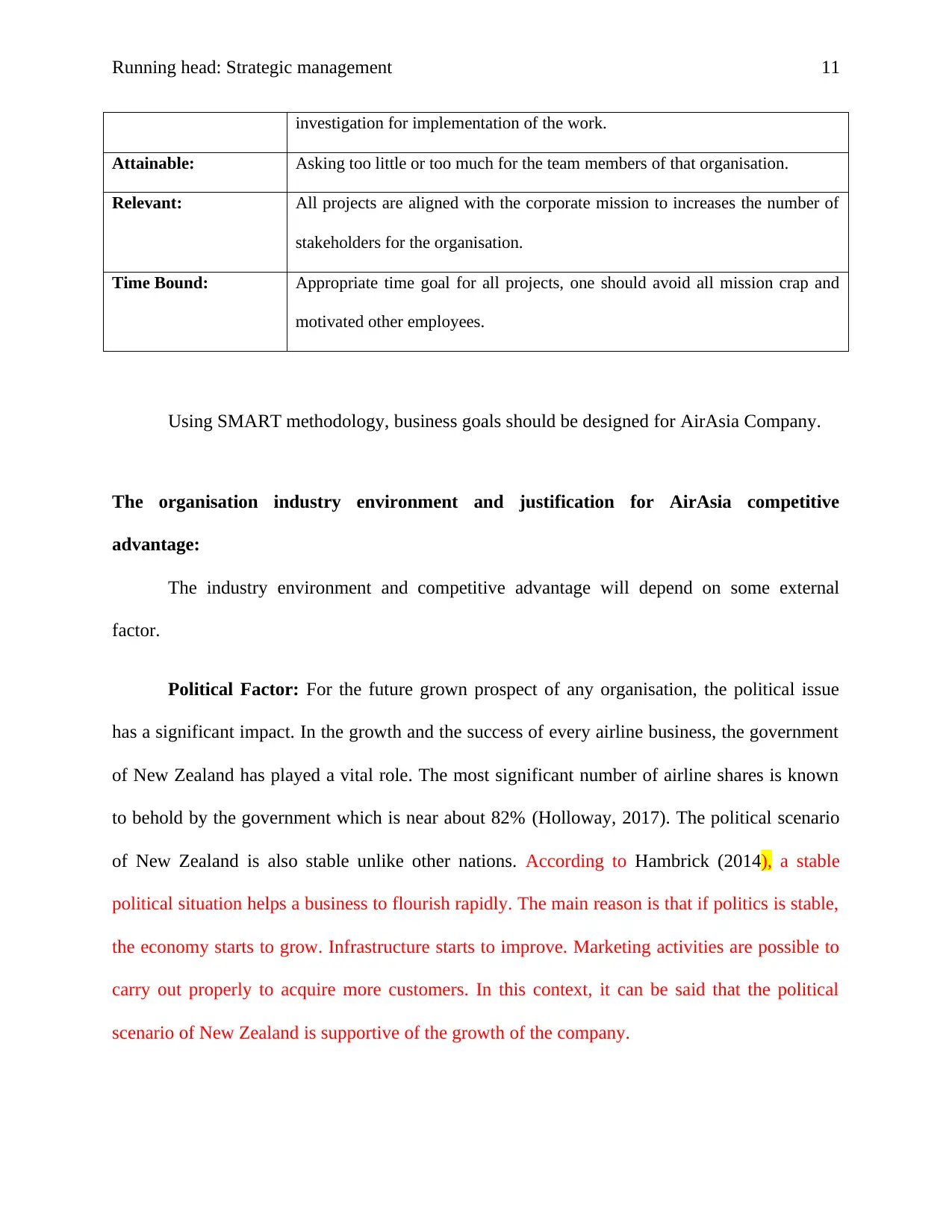
Running head: Strategic management 11
investigation for implementation of the work.
Attainable: Asking too little or too much for the team members of that organisation.
Relevant: All projects are aligned with the corporate mission to increases the number of
stakeholders for the organisation.
Time Bound: Appropriate time goal for all projects, one should avoid all mission crap and
motivated other employees.
Using SMART methodology, business goals should be designed for AirAsia Company.
The organisation industry environment and justification for AirAsia competitive
advantage:
The industry environment and competitive advantage will depend on some external
factor.
Political Factor: For the future grown prospect of any organisation, the political issue
has a significant impact. In the growth and the success of every airline business, the government
of New Zealand has played a vital role. The most significant number of airline shares is known
to behold by the government which is near about 82% (Holloway, 2017). The political scenario
of New Zealand is also stable unlike other nations. According to Hambrick (2014), a stable
political situation helps a business to flourish rapidly. The main reason is that if politics is stable,
the economy starts to grow. Infrastructure starts to improve. Marketing activities are possible to
carry out properly to acquire more customers. In this context, it can be said that the political
scenario of New Zealand is supportive of the growth of the company.
investigation for implementation of the work.
Attainable: Asking too little or too much for the team members of that organisation.
Relevant: All projects are aligned with the corporate mission to increases the number of
stakeholders for the organisation.
Time Bound: Appropriate time goal for all projects, one should avoid all mission crap and
motivated other employees.
Using SMART methodology, business goals should be designed for AirAsia Company.
The organisation industry environment and justification for AirAsia competitive
advantage:
The industry environment and competitive advantage will depend on some external
factor.
Political Factor: For the future grown prospect of any organisation, the political issue
has a significant impact. In the growth and the success of every airline business, the government
of New Zealand has played a vital role. The most significant number of airline shares is known
to behold by the government which is near about 82% (Holloway, 2017). The political scenario
of New Zealand is also stable unlike other nations. According to Hambrick (2014), a stable
political situation helps a business to flourish rapidly. The main reason is that if politics is stable,
the economy starts to grow. Infrastructure starts to improve. Marketing activities are possible to
carry out properly to acquire more customers. In this context, it can be said that the political
scenario of New Zealand is supportive of the growth of the company.
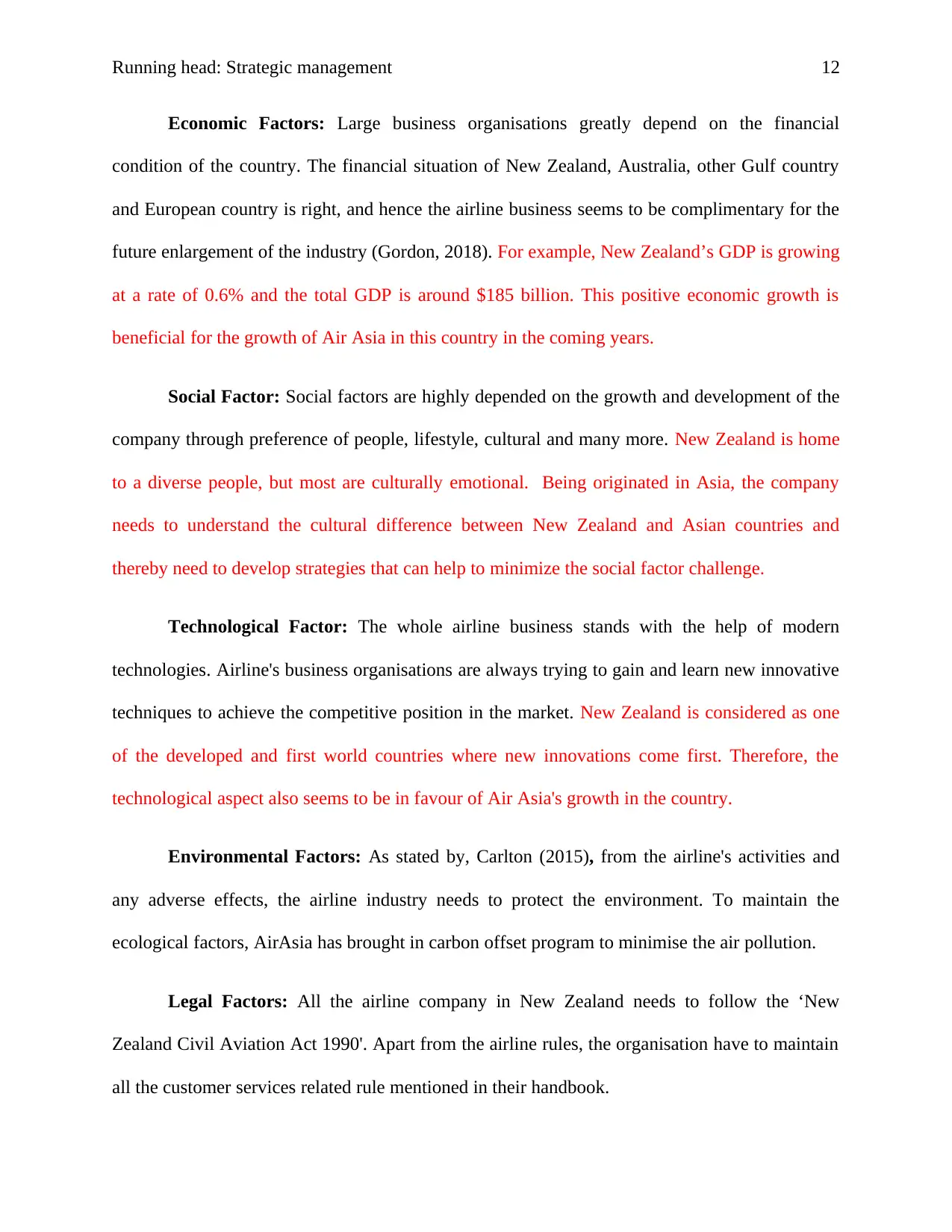
Running head: Strategic management 12
Economic Factors: Large business organisations greatly depend on the financial
condition of the country. The financial situation of New Zealand, Australia, other Gulf country
and European country is right, and hence the airline business seems to be complimentary for the
future enlargement of the industry (Gordon, 2018). For example, New Zealand’s GDP is growing
at a rate of 0.6% and the total GDP is around $185 billion. This positive economic growth is
beneficial for the growth of Air Asia in this country in the coming years.
Social Factor: Social factors are highly depended on the growth and development of the
company through preference of people, lifestyle, cultural and many more. New Zealand is home
to a diverse people, but most are culturally emotional. Being originated in Asia, the company
needs to understand the cultural difference between New Zealand and Asian countries and
thereby need to develop strategies that can help to minimize the social factor challenge.
Technological Factor: The whole airline business stands with the help of modern
technologies. Airline's business organisations are always trying to gain and learn new innovative
techniques to achieve the competitive position in the market. New Zealand is considered as one
of the developed and first world countries where new innovations come first. Therefore, the
technological aspect also seems to be in favour of Air Asia's growth in the country.
Environmental Factors: As stated by, Carlton (2015), from the airline's activities and
any adverse effects, the airline industry needs to protect the environment. To maintain the
ecological factors, AirAsia has brought in carbon offset program to minimise the air pollution.
Legal Factors: All the airline company in New Zealand needs to follow the ‘New
Zealand Civil Aviation Act 1990'. Apart from the airline rules, the organisation have to maintain
all the customer services related rule mentioned in their handbook.
Economic Factors: Large business organisations greatly depend on the financial
condition of the country. The financial situation of New Zealand, Australia, other Gulf country
and European country is right, and hence the airline business seems to be complimentary for the
future enlargement of the industry (Gordon, 2018). For example, New Zealand’s GDP is growing
at a rate of 0.6% and the total GDP is around $185 billion. This positive economic growth is
beneficial for the growth of Air Asia in this country in the coming years.
Social Factor: Social factors are highly depended on the growth and development of the
company through preference of people, lifestyle, cultural and many more. New Zealand is home
to a diverse people, but most are culturally emotional. Being originated in Asia, the company
needs to understand the cultural difference between New Zealand and Asian countries and
thereby need to develop strategies that can help to minimize the social factor challenge.
Technological Factor: The whole airline business stands with the help of modern
technologies. Airline's business organisations are always trying to gain and learn new innovative
techniques to achieve the competitive position in the market. New Zealand is considered as one
of the developed and first world countries where new innovations come first. Therefore, the
technological aspect also seems to be in favour of Air Asia's growth in the country.
Environmental Factors: As stated by, Carlton (2015), from the airline's activities and
any adverse effects, the airline industry needs to protect the environment. To maintain the
ecological factors, AirAsia has brought in carbon offset program to minimise the air pollution.
Legal Factors: All the airline company in New Zealand needs to follow the ‘New
Zealand Civil Aviation Act 1990'. Apart from the airline rules, the organisation have to maintain
all the customer services related rule mentioned in their handbook.
⊘ This is a preview!⊘
Do you want full access?
Subscribe today to unlock all pages.

Trusted by 1+ million students worldwide
1 out of 23
Related Documents
Your All-in-One AI-Powered Toolkit for Academic Success.
+13062052269
info@desklib.com
Available 24*7 on WhatsApp / Email
![[object Object]](/_next/static/media/star-bottom.7253800d.svg)
Unlock your academic potential
Copyright © 2020–2025 A2Z Services. All Rights Reserved. Developed and managed by ZUCOL.





